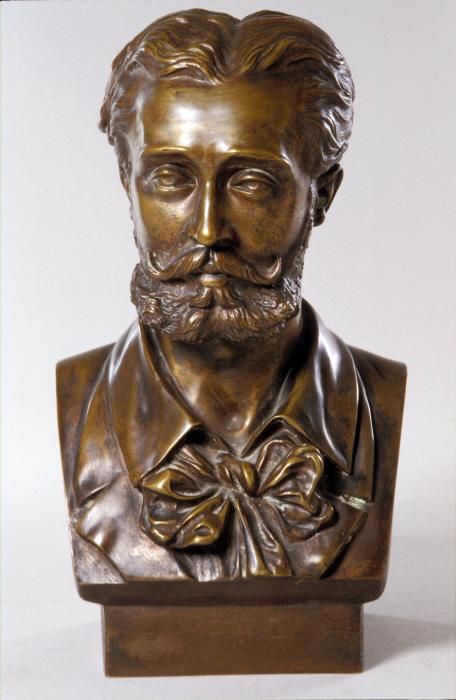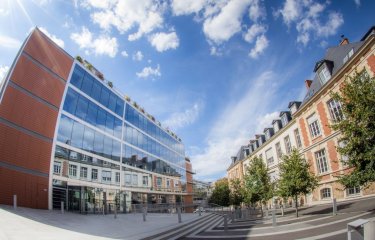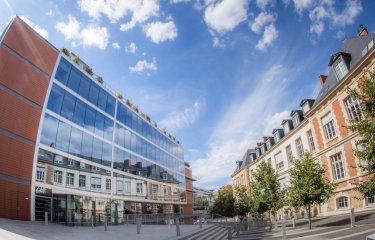The square known as "Place Daniel Iffla-Osiris", at the junction of boulevard Haussmann and boulevard des Italiens in Paris, was officially opened on June 27, 2018. This inauguration is an ideal opportunity to look back on the story of Daniel Iffla-Osiris, one of the greatest philanthropists of the 19th century. At his death in 1907, he left behind the largest legacy ever received by the Institut Pasteur.
Donations and public generosity were the very foundation upon which the Institut Pasteur was built. Following on from the success of the first rabies vaccinations, in 1887 Louis Pasteur launched an international appeal to fund his building project. The outpouring of generosity in France and throughout the world was unprecedented. At the opening ceremony of the Institut Pasteur in 1888, the scientist declared: "And here we see it finished, this grand building of which it may be truly said that there is not a single stone that is not the material sign of a generous thought. All the virtues have paid tribute towards the erection of this abode of toil."
Since that time public support has never waned.
In 1907, a famous financier, Daniel Iffla-Osiris, died. He left his entire fortune (except for a small number of specific legacies) to the Institut Pasteur. He explained in his will: "I have always had a keen desire to promote scientific discoveries that might help alleviate the suffering of others, and I hereby bequeath my universal legacy and responsibility for its execution to the memory of the great Pasteur, one of the most marvelous and worthy representatives of my country."

Daniel Iffla-Osiris was born in Bordeaux in 1825 into a local Jewish family; his grandfather had volunteered for the armed forces in 1791, and after having fought as a second lieutenant in the Alps and in the Siege of Toulon, he served with distinction in the eastern Pyrenees during the Battle of Boulou.
The payment of the legacy, the largest in the Institut Pasteur's history, representing a total of 36 million gold francs, was overseen by the executors, who included former French President Émile Loubet. Converting the amount into modern-day currency is a hypothetical exercise, but we can estimate that it equates to approximately €130 million.
The wealthy testator also seems to have had another reason for his generosity. It appears that the Institut Pasteur has Claude Debussy to thank – albeit indirectly – for Osiris' legacy. The musician had left his wife to live with Osiris' niece. Osiris, shocked at the behavior of his niece, who was married, decided to disinherit her – and her loss was the Institut Pasteur's gain! (1)
(1) see Rebatet L., Une Histoire de la musique. R. Laffont, coll. Bouquins, 1979, p. 645
The gift enabled the Institut Pasteur to purchase new plots of land on rue Dutot (now rue du Docteur-Roux), rue des Volontaires and rue de Vaugirard, which opened up possibilities for extending the site. The Institut du Radium was also set up as a direct result of Osiris' legacy.
The Institut Pasteur only withdrew from the Institut du Radium in 1974, following the latter's merger with the Fondation Curie (now the Institut Curie), which had been set up in 1921 as a center for medical applications within the Institut du Radium. The Institut Pasteur President is still a full member of the Board of Directors of the Institut Curie.
The Osiris legacy had an undeniable impact on the future of the Institut Pasteur, arriving at a key moment in its history and providing it with the resources it needed to plan for the future. In addition to the projects already mentioned, it gave the Institut Pasteur a strong capital base, providing sufficient revenue for its day-to-day activities – even though the successive devaluations of the franc following the First World War gradually ate into this income.
Osiris, one of the greatest philanthropists of the 19th century
Daniel Iffla (1825-1907) settled in Paris at a relatively young age. Despite his humble beginnings, he proved to be a skilled financier. He invested in all the major ventures of the Second French Empire and amassed a huge fortune. Adopting the literary pseudonym "Osiris", he undertook to devote his fortune to philanthropy, reflecting the Egyptian god's charitable, patriotic values. He donated prolifically to a wide range of causes.

To cite just a few examples, he funded public fountains in Bordeaux; a municipal nursery and serum therapy institute in Nancy, where he also paid for a statue of Joan of Arc; a modern operating theater at Salpêtrière Hospital in Paris; and the statue of Alfred de Musset in front of the Comédie-française in Paris. In Belgium, near the town of Waterloo, he purchased a vast plot to build a monument in memory of the Grenadier Guards who had fallen near La Haye Sainte. He also contributed to the building of several synagogues, especially in Paris, Nancy, Arcachon and Tunis. Well before the famous "Restos du Cœur" charity was set up, Osiris opened a "soup boat" in Bordeaux.
Finally, a lesser-known fact is that Osiris purchased the Château de Malmaison, and after having fully restored it, gave it as a gift to the French government in 1904. He merely requested in his will that a building be constructed near the château to house some of the artworks he had acquired throughout his lifetime. The Osiris Museum finally opened in... May 2011.






